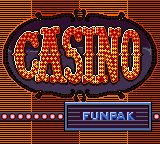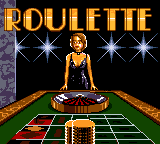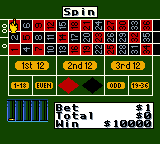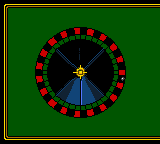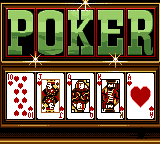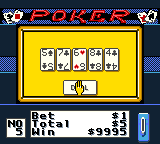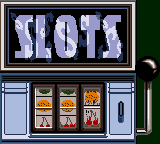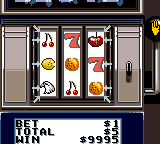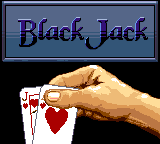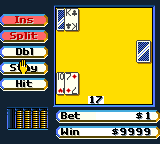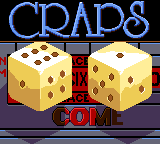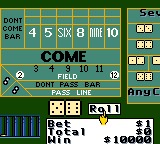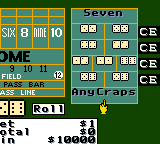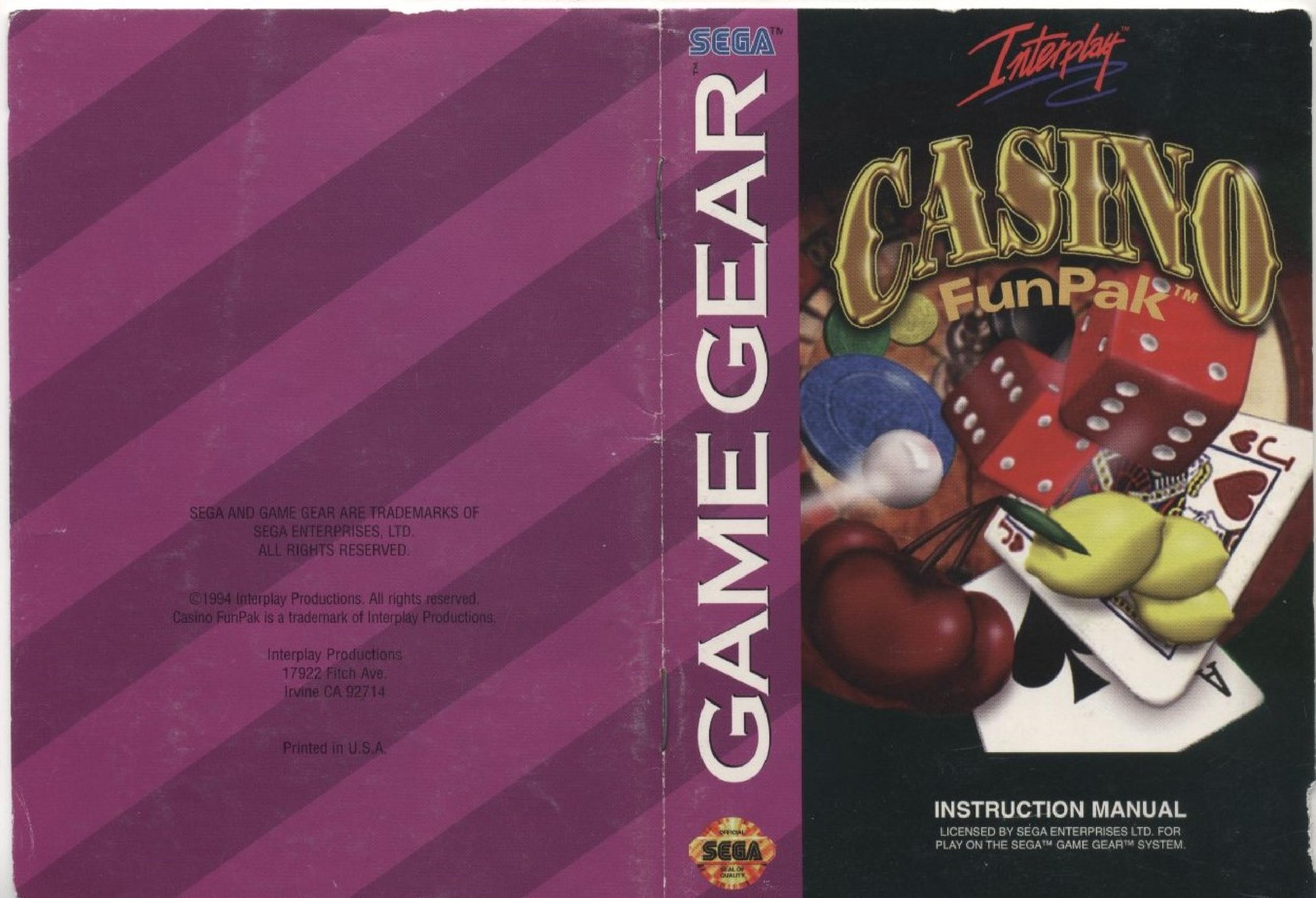In roulette, the player places bets on a single number (0, 00, or 1-36), groupings of numbers, the color red or black, whether the number is odd or even (0 and 00 are not considered either), or if the numbers are high (19–36) or low (1–18). Then a ball is dropped on a spinning wheel, which has a track next to a series of marked numbers, which alternate red and black (except for the 0 and 00 at the beginning and end, which are neither). Bets are made by dropping chips on a table. The player decides the value of each stack of chips at the start of the game. The D-Pad moves the cursor,  drops or picks up chips, and drops or picks up chips, and  spins the wheel. When the wheel and the ball stop moving, bets are paid out based on where the ball stops. spins the wheel. When the wheel and the ball stop moving, bets are paid out based on where the ball stops.
A single bet on a single number can be made by dropping the chips in the middle of the number; these bets pay out 35 times the original bet. A double bet (17 times the original bet) on two numbers can be made by placing the chips in between two numbers. A triple bet (11 times the original bet) on a column of numbers can be made by placing the chips on the dividing line between the number on the edge and the rest of the board. A quadruple bet (8 times the original bet) on four numbers can be made by placing the chips on the corner between four numbers. A six bet (5 times the original bet) on two columns of numbers can be made by placing the chips between two columns on the dividing line between the number on the edge and the rest of the board. Finally, a twelve bet (2 times the original bet) on twelve numbers can be made by placing the chips on the spots marked "1st 12," "2nd 12," or "3rd 12."
|
This game simulates a video poker machine. The machine has a coin slot that the player can select to insert up to five tokens. The player decides the value of each token at the start of the game.  inserts a token and inserts a token and  removes a token. The goal of video poker is to make the most valuable poker hand possible. After inserting tokens, the player can select Draw to draw a hand of five cards. The player can then mark the cards to hold (which appear with arrows above and below them), then hit Deal. This deals new cards for the cards that were not marked. The player can then hit Score to receive a payout if any poker hand was made. removes a token. The goal of video poker is to make the most valuable poker hand possible. After inserting tokens, the player can select Draw to draw a hand of five cards. The player can then mark the cards to hold (which appear with arrows above and below them), then hit Deal. This deals new cards for the cards that were not marked. The player can then hit Score to receive a payout if any poker hand was made.
A pair of Jacks pays even money, then Two Pair pays 2 times the original bet, Three of a Kind pays 3 times, a Straight pays 4 times, a Flush pays six times, a Full House pays 9 times, Four of a Kind pays 25 times, a Straight Flush pays 50 times, and a Royal Flush pays 250 times.
|
| Blackjack is a card game where the goal is to have a more valuable hand of cards than the dealer without "busting" (going over 21). Numbered cards are worth their face value, face cards are worth 10 points, and Aces can be counted as either 1 or 11 points.
On each hand, the player and the dealer are dealt out two cards each. One of the dealer's cards is laid face up so the player can see it, while the other is laid face down. The game shows the numeric value of the player's hand. If the player draws 21 initially, it is called a "blackjack" and wins automatically. Otherwise, the player can choose to Stay (play the hand against the dealer's cards) or Hit (draw another card to increase the value of the hand, risking a bust). The player also has the option to Dbl, which doubles the bet, draws one more card, and stays. When the player is dealt two cards of the same value, the player can choose Split, which splits the cards into two separate hands and play both against the dealer. This requires making a second bet with the same value as the first. When the dealer is showing an Ace, the player can choose Ins, which is an additional bet, separate from the original bet on the player's hand, that the dealer has a blackjack. This bet costs half the amount of the original bet but pays out double (acting as a break-even if the dealer has 21).
The player wins by having a higher hand than the dealer. Most bets pay even money, but getting a blackjack pays one and a half times the bet. The player loses by busting or by having a lower hand than the dealer after staying. If both the player and the dealer have the same value of cards, the round is considered a "push" and the player's wager is returned. The dealer always hits when holding a hand worth less than 17 and stays otherwise.
|
Craps is a dice game where the player bets on the outcome of rolling two dice. Up to six bets can be placed by dropping chips on a table. There are many different kinds of bets that can be made. The D-Pad moves the cursor,  drops or picks up chips, and drops or picks up chips, and  rolls the dice. The screen scrolls slightly horizontally to show the entire table. rolls the dice. The screen scrolls slightly horizontally to show the entire table.
Before the "come-out" roll (the first roll of the round), the player must place a bet on the Pass or Don't Pass line (any other bets are ignored until the "point" is established). A roll of 2, 3, or 12 is a loss for any bets on the Pass line (but 2 and 3 are wins for Don't Pass and 12 is a draw). A roll of 7 or 11 is a win for the Pass line and a loss for the Don't Pass line. On the come-out roll, rolling any other number (4, 5, 6, 8, 9, or 10) becomes the player's "point" (which is marked by placing a disc above the corresponding number on the table). If the player rolls the point again before rolling a 7, the Pass line wins and the Don't Pass line loses. If the player rolls a 7 before rolling the point again, the Don't Pass line wins and the Pass line loses. In either case, the round ends.
A Come bet is similar to a Pass line bet, but it is only placed after the point has been established; the chips are moved from the Come area to the corresponding numbered box near the top of the table, and the bet is won if that number is won before rolling a 7. Don't Come is the opposite of the Come bet, similar to Don't Pass. A Free Odds (Pass and Come) bet can be made by making an additional bet on the Pass line or on one of the numbered boxes (for a Come bet) after the point has been established. One one additional Pass or Come bet can be made. These bets pay out the true odds of the bet without a house advantage: 4 & 10 pay out 2 to 1, 5 & 9 pay out 3 to 2, and 6 & 8 pay out 6 to 5.
A Free Odds (Don't Pass and Don't Come) bet is placed in the top row of boxes above the large numbers at the top of the table and above where the point is marked. This bet is that a 7 will be rolled before the point. Since the 7 is the most common roll, the payout is less than the amount bet. A Place bet is placed below the large numbers at the top of the table and is a bet that a certain number will be rolled before a 7. These bets only become active after a point is established and can pay out multiple times with no limit if a number is rolled more than once. 4 & 10 pay out 9 to 5, 5 & 9 pay out 7 to 5, and 6 & 8 pay out 7 to 6. A Lay bet is placed on top of all of the other bets above the large numbers at the top of the table (outside the margin of the layout) and is a bet that a 7 will be rolled before the marked number (essentially the opposite of a Place bet). 4 & 10 pay out 1 to 2, 5 & 9 pay out 2 to 3, and 6 & 8 pay out 5 to 6. Big 6 and Big 8 are the 6 and the 8 in the bottom-left corner of the table and are the same as Place bets on 6 or 8 but pay out even money. Field bets are placed in the Field area (between the Don't Pass bar and Come area) and are one-roll bets that a certain number will be rolled next. 3, 4, 9, 10, and 11 pay out even money, 2 pays out 2 to 1, and 12 pays out 3 to 1.
The right side of the table has Hardway wagers, depicted by dice. These are bets that a particular combination of dice will come up before any other combination for the same amount or a 7. Double 2s or 5s pay out 7 to 1, double 3s or 4s pay out 9 to 1, 2 or 12 pays out 29 to 1, and 3 or 11 pay out 14 to 1. A bet on Seven is a one-roll bet that the next roll will be any combination producing 7 (the number with the most combinations of dice that produce it) and pays out 4 to 1. A bet on Any Craps is a one-roll bet that the next roll will be a craps (2, 3, or 12) and pays out 7 to 1. A bet on CE (Craps Eleven) is a bet that the next roll will be either a craps (2, 3, or 12) or an 11 and pays out 3 to 1.
|
![]() or
or ![]() to play it. The player starts with $10,000 that can be gambled on any of the games.
to play it. The player starts with $10,000 that can be gambled on any of the games.
![]() or
or ![]() confirms the selection. Between rounds, the player can change the amount bet with HOLD START
confirms the selection. Between rounds, the player can change the amount bet with HOLD START ![]() (otherwise, the game makes the previous bet again). At any time, the player can raise a menu with HOLD START
(otherwise, the game makes the previous bet again). At any time, the player can raise a menu with HOLD START ![]() to exit the game and return to the casino floor, move on to the next game (in a tournament), or change the music.
to exit the game and return to the casino floor, move on to the next game (in a tournament), or change the music.
